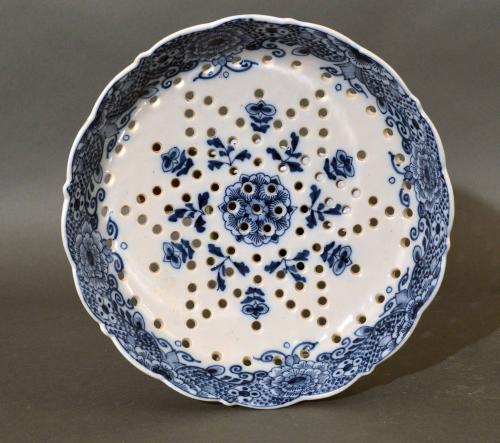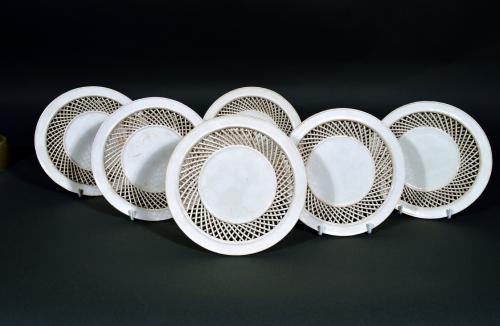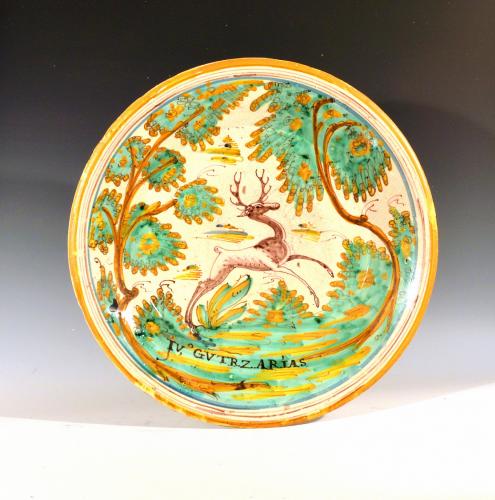


This object is eligible for a Certificate of BADA Provenance
The BADA Standard
- Since 1918, BADA has been the leading association for the antiques and fine art trade
- Members are elected for their knowledge, integrity and quality of stock
- Our clients are protected by BADA’s code of conduct
- Our dealers’ membership is reviewed and renewed annually
- Bada.org is a non-profit site: clients deal directly with members and they pay no hidden fees
French Porcelain Paris Oval Trencher Salts, André Leboeuf rue Thiroux, Paris, Porcelaine a la Reine,
Circa 1780
The trencher salts have an oval stepped moulded body painted with a band of cornflowers, fuschia-coloured flower heads and leaves with a gilt band of swags above and below.
Dimensions: 3 1/4 inches wide x 2 1/4 inches deep x 1 1/2 inches high (8.26cm wide x 5.72cm x 3.81cm high)
Mark: Crown mark with initial A for Marie Antoinette in red. Porcelaine à la Reine was made in the factory of Marie Antoinette known as Fabrique de la Reine (The Queen's Factory).
The factory was founded in 1776 and Leboeuf registered an A as the mark. The crown was added about two years later when Queen Marie-Antoinette gave the factory her protection.
Reference: 1994. French Porcelain, A Catalogue of the British Museum Collection.London: British Museum, Dawson, Aileen, Page 148 for a brief history of this factory.
Ref. see pp. 192-99 for the rue Thiroux factory, and p. 344 for the mark. (http://marie-antoinette.forumactif.org/t2430-marie-antoinette-et-la-manufacture-de-la-rue-thiroux)
The so-called Queen's factory is founded by André Leboeuf who submits a bid to the Lieutenant General of Police on September 9, 1776 and obtains the authorization to create a porcelain factory rue Thiroux at the Chaussée d'Antin. In July 1777, Leboeuf warned the public through advertisements, posters and various notices that the factory is in a position to produce "pieces of service and utility, taste and decoration and groups biscuits." A year later, in December 1778, Leboeuf announced in the same sheet that "The Queen willing to honor his protection and their establishment to allow his name to be worn, each piece newly manufactured will now be marked below A crowned, first letter of His Majesty's name ".
The vast majority of Parisian factories have, indeed, quickly sought the protection of a member of the royal family. Thus the Count of Provence, the Count of Artois, the Duke of Orleans, the Queen and even the very young Duke of Angouleme, aged six, grant their patronage to a private manufacture. The main interest for the factories is to fight more effectively against the privilege of the royal manufacture of Sèvres, but also to enjoy certain advantages such as the possibility of affixing the illustrious coat of arms over the door or on the bills or even to use as a mark a monogram formed of the initials of the protectors. This protection also offers an increase in the clientele, in the first rank of which is the protector himself.
It is also attested that in 1785 and 1786, the Thiroux Street Manufactory delivered porcelains to Marie-Antoinette for Fontainebleau, her small apartments in the Tuileries and her castle in Trianon.
Dimensions
8.26cm wide x 5.72cm x 3.81cm highStock number
NY9090The BADA Standard
- Since 1918, BADA has been the leading association for the antiques and fine art trade
- Members are elected for their knowledge, integrity and quality of stock
- Our clients are protected by BADA’s code of conduct
- Our dealers’ membership is reviewed and renewed annually
- Bada.org is a non-profit site: clients deal directly with members and they pay no hidden fees






